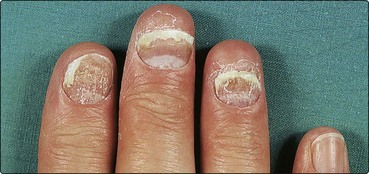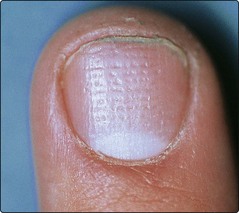Disorders of nails
Congenital disease
A number of usually rare congenital conditions can affect the nails. In the nail–patella syndrome, the nails (and patellae) are absent or rudimentary. The nails in pachyonychia congenita are thickened and discoloured from birth. Nail dystrophy is a feature of dystrophic epidermolysis bullosa (p. 90). Racket nails, characterized by a broad short thumbnail, is the commonest congenital nail defect. It is dominantly inherited and more common in women.
Dermatoses
The nails are commonly involved in skin disease (Figs 1 and 2), and are routinely assessed in a dermatological examination. Details are given in Table 1, and a differential diagnosis of the changes is shown in Table 2. Treatment is aimed at the associated dermatosis; care of the hands (p. 38) is especially important.
Table 1 Nail involvement in common dermatoses
| Dermatosis | Nail changes |
|---|---|
| Alopecia areata | Fine pitting, roughness of nail surface |
| Darier’s disease | Longitudinal ridges, triangular nicks at distal nail edge |
| Eczema | Coarse pitting, transverse ridging, dystrophy, shiny nails due to rubbing |
| Lichen planus | Thinned nail plate, longitudinal grooves, adhesion between distal nail fold and nail bed (pterygium), complete nail loss |
| Psoriasis | Pitting, nail thickening, onycholysis (separation of nail from nail bed), brown discoloration, subungual hyperkeratosis |
Table 2 Differential diagnosis of nail changes in dermatoses and systemic disease
| Change | Description of nail | Differential diagnosis |
|---|---|---|
| Beau’s lines | Transverse grooves | Any severe systemic illness that affects growth of the nail matrix |
| Brittle nails | Nails break easily, usually at distal margin | Effect of water and detergent, iron deficiency, hypothyroidism, digital ischaemia |





